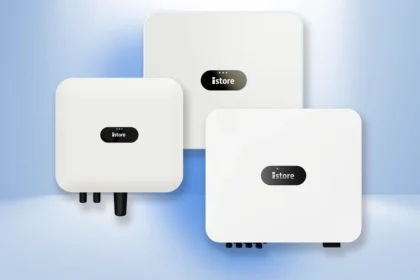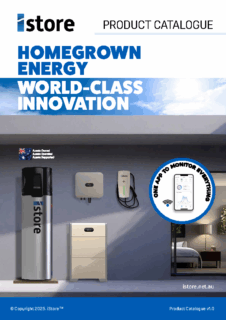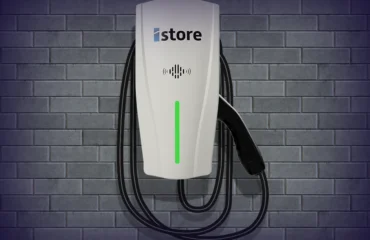
Most homeowners and business owners don’t have the technical knowledge to choose solar components for their solar systems, so they rely on professional solar retailers and installers like yourself to guide them toward the best options.
You know a solar inverter is the key player in converting solar energy into usable power. If it’s unreliable or inefficient, the entire system suffers, leading to unhappy customers, warranty headaches, and costly callbacks!
That’s why choosing the right inverter is not just about specs but also about safety, reliability, and long-term value.
At iStore, we understand this. Our solar inverters are built for peace of mind, performance, and affordability, making them a top choice for retailers and installers looking to offer products that deliver real results.
What is the best solar inverter to recommend to your customers? Let’s break down the features that make an inverter truly “the best”.
Definition and Function of Solar Inverters
A solar inverter converts the DC electricity generated from solar panels into the AC electricity homes and businesses use. Various inverter types are available to suit different system sizes, energy needs, and installation setups. These include String inverters Microinverters Hybrid inverters Central inverters 3-phase inverters We’ll go into detail about these later on.How Solar Inverters Work
You know how a solar inverter works, but explaining that to customers can be challenging!
Try this:
“A solar inverter is like a translator for your solar power system. Imagine you’re travelling to Japan. You understand English (DC electricity), but the locals only speak Japanese (AC electricity). To communicate with a local, you need a translator (the inverter) to convert your English into Japanese.
Solar panels absorb sunlight and generate DC electricity. Homes and businesses run on AC electricity. Without an inverter, solar power is not compatible with appliances, lighting, or the grid.”
Here’s a more technical explanation if they’re interested.
- Solar Panels Capture Sunlight: When the sun shines on solar panels, the photovoltaic (PV) cells absorb the sunlight, exciting electrons and generating direct current (DC) electricity.
- The Inverter Receives DC Power: The raw DC electricity from the panels can’t be used directly in most homes or businesses, which run on alternating current (AC) electricity. The solar inverter receives this DC power and prepares it for conversion.
- MPPT Technology Optimises Energy Production: The inverter uses Maximum Power Point Tracking (MPPT) technology to adjust the panels in changing sunlight conditions (shade, cloud cover, and temperature changes) to extract the maximum possible energy.
- DC Power Converts to AC Power: Inside the inverter, the DC electricity switches rapidly back and forth, creating an alternating current (AC) waveform that matches the electricity used in homes and businesses.
- Grid Synchronisation and Safety Features Activate: If the system connects to the electricity grid, the inverter synchronises the converted AC power with the grid’s voltage and frequency. Anti-islanding protection automatically shuts off power if the grid goes down, preventing unsafe backfeeding into power lines during outages.
- Power is Used or Sent to the Grid/Battery: The converted AC power flows into the home or business, powering appliances, lighting, and other electrical devices. Excess energy can be exported to the grid for credits (if grid-tied) or stored in a battery for later use (if part of a hybrid or off-grid system).
Importance of Solar Inverters for Solar Panels
A solar inverter
- Converts Energy for Use. The inverter transforms raw DC power from solar panels into functional AC power for everyday use.
- Optimises Solar System Efficiency. A high-quality inverter maximises power output, improving energy efficiency and system performance.
- Monitors System Performance. Many modern inverters have monitoring features that track energy production, efficiency, and potential system issues.
- Enables Grid Connection. If a system connects to the grid, the inverter ensures that the electricity matches grid standards for seamless integration.
- Supports Battery Storage. In hybrid systems, inverters manage energy flow between solar panels, batteries, and the grid.
What Makes a Solar Inverter the Best? Key Features to Look For
Safety
A solar inverter should protect the solar power system, the home or business, and the people who depend on its electricity. Safety features prevent electrical hazards, extend the inverter’s lifespan, and comply with Australian electrical and grid standards.
The best solar inverter should have the following safety features.
- Arc Fault Protection: Detects and stops dangerous electrical arcs caused by faulty wiring, aging components, and loose connections, reducing the risk of fires.
- Cooling Systems: Heat sinks (metal components that absorb and dissipate heat) and passive cooling (which relies on natural airflow) prevent inverters from overheating and failing.
- Surge Protection: Absorbs sudden voltage spikes caused by lightning or grid fluctuations, shielding the inverter from damage.
- Anti-Islanding Protection: Prevents the solar system from sending power back to the grid during a blackout, protecting utility workers and complying with regulations.
- Ground Fault Detection: Monitors the electrical circuit for leaks (where electricity unintentionally flows to the ground) and automatically shuts down the system to prevent electric shocks and fires.
- Rapid Shutdown Function: Quickly shuts down the system in an emergency, protecting installers and emergency responders from electrical hazards.
Reliability
A reliable solar inverter will produce consistent energy for many years, be less likely to break down, and be cheaper to maintain.
For an inverter to be considered reliable, it must have
- High-Efficiency Ratings. These translate to maximum energy conversion, reduced losses, and the delivery of more usable power from solar panels.
- Proven Durability. A quality inverter should have an IP65+ rating for weather protection, heat-resistant components, and robust build quality to withstand extreme temperatures, humidity, and dust.
- Consistent Grid Stability. To smoothly manage voltage fluctuations, grid instability, and load changes for stable operation, even during peak demand periods.
- A Long Warranty. A strong manufacturer-backed warranty of at least 10 years reflects confidence in the product’s longevity.
- Comprehensive Customer Support. Local technical support and service availability for warranty claims, installation queries, and performance issues mean installers and customers get fast, effective solutions when needed.
- A Proven Track Record. Trusted brands will have a history of positive user feedback.
Affordability and Value
When recommending an inverter, balance upfront cost with performance and durability so your customers get the best return on their investment. A well-priced inverter that performs dependably for years is a far better investment than a budget option that fails prematurely or needs frequent servicing!
Here’s what to consider when evaluating affordability and value.
- Cost vs. Performance: While a lower-cost inverter may save money upfront, it could lead to higher maintenance costs or early replacement. Investing in a reliable, efficient model often yields greater savings over time.
- Warranty Coverage: A longer, manufacturer-backed warranty adds value by protecting against costly repairs or replacements.
- Efficiency and Energy Savings: A high-efficiency inverter converts more solar energy into usable electricity, reducing waste and maximising energy bill savings.
- Built-in Features: Some inverters come with advanced monitoring, surge protection, and battery compatibility, which provide added benefits without extra costs.
- Rebates and Incentives: Certain reputable inverters may be eligible for government rebates or incentives, making them more affordable.
Compatibility
A solar inverter must integrate with the rest of the solar power system for optimal performance. Choosing the wrong inverter can lead to inefficiencies, limited functionality, and even system failures.
An inverter should work well with
- Solar Panel Capacity and Voltage Range. The inverter must match the solar panels’ total power output and voltage to avoid energy losses and system inefficiencies.
- Battery Storage Systems. If the system includes (or may later include) a solar battery, a hybrid inverter will smoothly manage energy between solar panels, batteries, and the grid.
- Grid Requirements and Regulations. A compliant inverter must meet Australian grid standards, including voltage, frequency, and safety requirements for seamless grid connection and feed-in tariff eligibility.
- Monitoring and Smart Features. Many inverters integrate with Wi-Fi monitoring platforms, allowing customers and installers to track performance, detect issues, and optimise energy use.
- Backup Power and Off-Grid Systems. Some inverters can support off-grid or backup power functionality to keep essential appliances running during power outages.
Ease of Use and Monitoring
The best inverters should be easy for installers to install and easy for customers to operate. That way, everybody wins!
What makes an inverter easy to use and monitor?
- Simple Installation and Setup: Clear wiring terminals, straightforward mounting options, and an intuitive interface make the installation process quicker and reduce the risk of errors.
- Real-Time Energy Monitoring: Wi-Fi or Bluetooth connectivity lets users track energy production, consumption, and system health via a mobile app or web portal.
- Automated Alerts and Diagnostics: Smart inverters can detect faults, send automatic alerts, and give troubleshooting insights, helping installers and users resolve issues quickly before they impact performance.
- User-Friendly Display: Customers can check their system’s status at a glance on a built-in LCD or LED screen displaying performance metrics.
- Remote Access and Smart Integration: Some advanced inverters integrate with smart home systems, battery storage, and third-party monitoring platforms, giving users more control over their energy usage.
Why iStore Solar Inverters Are Among the Best
Safety First
The safety features of iStore inverters protect homes and businesses while keeping solar systems running optimally for the long haul. Your customers can rest assured knowing that their safety is taken care of.
These safety features include
- Arc Fault Circuit Interrupter (AFCI): Detects and shuts down electrical arcs within 0.5 seconds, eliminating potential fire hazards.
- AI-Powered Arc Fault Detection: Traditional arc detection systems use preset thresholds to identify faults. AI-powered arcing protection goes a step further, using algorithms that “learn” and adapt to recognise even subtle patterns that indicate potential arcing. The system then automatically shuts down if an arc is detected.
- Natural Cooling Systems: Passive cooling systems relying on natural airflow and heat sinks to absorb and dissipate heat prevent our inverters from overheating and failing. As a bonus, these systems do not use fans or moving parts, lessening operating noise and system wear.
- Residual Current Monitoring Unit (RCMU): Continuously monitors the electrical flow and detects any leakage current that may occur due to damaged insulation, moisture, or wiring faults. If leakage is detected, the system triggers an alert or automatic shutdown, preventing electric shocks, fire hazards, and equipment damage.
Affordability Without Compromising Quality
Customers want a cost-effective solar system that delivers long-term savings, while retailers must offer high-quality products at competitive prices to stay ahead in the market.
iStore makes premium solar solutions more accessible by offering top-tier inverters at highly competitive prices—without cutting corners on performance, safety, or durability. With iStore, you can confidently provide customers with reliable, efficient inverters that won’t break the bank.
To add even more value, we offer free shipping and exclusive promotions.
For example, customers who purchase an iStore inverter between August 1, 2023, and July 1, 2025, receive a promotional 2-year warranty extension in addition to the usual 10-year warranty.
But wait, there’s more!
With the purchase of an iStore solar inverter and 10kW battery, both solar retailers and end customers can win a BYD Dolphin Electric Vehicle valued at $38,890! Each purchase is eligible for a double entry in this Great iStore Giveaway—one for the retailer and one for the end customer.
Promoting Renewable Energy
Our solar inverters help homeowners and businesses reduce reliance on fossil fuels and lower their carbon footprint by converting renewable and abundant solar power into usable electricity.
With their battery-ready technology, our inverters also support energy storage. Users can store excess solar power and use it when needed instead of relying on grid electricity, further maximising self-sufficiency and sustainability.
By offering affordable, high-quality solar solutions, we empower more people to switch to solar, accelerating the transition toward a cleaner, greener energy future.
Customer Satisfaction Guaranteed
We provide comprehensive resources to support you throughout the process of purchasing and installing our solar inverters.
Our website has detailed user manuals, and if you have an installation question or need technical advice, our support team is ready to help. Just call us on 1300 515 640, email info@istore.net.au, or fill out this online form.
Our Solar Inverter Range
We can confidently say that our solar inverters are among the best on the market. As well as being loaded with safety features and competitively priced, they’re also battery-ready for future scalability.
What does that mean?
As energy prices change and feed-in tariffs decrease, more homeowners and businesses are looking for ways to store their excess solar power.
iStore inverters are designed to work with battery storage at any time, not just at installation. Customers won’t need costly upgrades or replacements when they decide to install an iStore battery, making their solar investment more flexible and future-proof.
So, “What is the best solar inverter in Australia?”
An iStore solar inverter, we reckon! Let’s take you through our range.
Single-Phase Hybrid Inverters
Our 5000/6000 1PH hybrid inverter connects to a single-phase power grid commonly used in most homes.
Its features include
- 2 x Maximum Power Point Tracking (MPPT): A technology that tracks and adjusts solar panels to operate at their maximum power point for optimal energy efficiency.
- IP65 Protection Rating: This inverter is highly rated for ingress protection, guaranteeing protection from dust and water.
- Quiet Operation: Under 30db!
- Remote Monitoring: Real-time monitoring, anywhere and anytime, with the Univers EMS and iStore solar energy management app.
Our 10kW 1 PH hybrid inverter has an extra Maximum Power Point (MPP) tracker for better energy optimisation and is super efficient, boasting up to 98.1% efficiency!
It also has three PV string inputs, which refer to the connections for multiple groups of solar panels (strings) to the inverter. This inverter can handle up to three separate panel arrays, allowing for greater flexibility in system design, such as panels facing different directions or installed at varying angles.
3-Phase Hybrid Inverters
Our 10kW/15kW/25kW 3 PH hybrid inverter and 5000/6000 3 PH hybrid inverter are suitable for larger homes, commercial buildings, and industrial facilities with a 3-phase grid connection. They handle more power and distribute it evenly throughout the house or building to reduce strain on the solar system.
With AFCI (Arc-Fault Circuit Interrupter) protection and an IP rating of 65 and 66, these models prioritise safety and resilience for homes and businesses with high energy demands.
Our other 3-phase inverter is the 29900/40000 3 PH inverter for commercial solar applications.
Along with 4 x MPPT and a 3-phase grid connection, it features
- 8-Strings Intelligent Monitoring: Tracking up to eight separate groups of solar panels, checking each group is working at its best.
- Power Line Communication (PLC): Allowing the inverter to send data over existing power lines, so no extra wiring is needed to monitor and control the system remotely.
- Smart I-V Curve Diagnosis Support: Automatically checks the performance of solar panels to detect any issues early and keep the system running smoothly.
- Maximum Efficiency: 98.6% efficiency!
Comparing Solar Inverter Types: Which Is Best for Your Customers?
String Inverters
A string inverter is the most common type of solar inverter used in residential and small commercial solar systems. It connects multiple solar panels in a series (or “string”), converting the combined DC electricity from all the panels into usable AC power for a home or business.
Pros
✔ Cost-Effective: More affordable than microinverters or hybrid systems.
✔ Proven Technology: Widely used and trusted in the solar industry.
✔ Easier Installation and Maintenance: Since there’s only one inverter, servicing is simpler than troubleshooting multiple microinverters.
✔ Good for Unshaded Roofs: Works efficiently when all panels receive consistent sunlight throughout the day.
Cons
✖ Performance Dependency: Since all panels in a string are connected to one inverter, their performance is linked. If one panel is shaded, dirty, or underperforming, it reduces the efficiency of the entire string.
✖ Limited Design Flexibility: Panels must be installed at the same angle and orientation for best performance.
✖ No Panel-Level Monitoring: Unlike microinverters, string inverters don’t allow for individual panel performance tracking.
Microinverters
Unlike string inverters, which manage multiple solar panels at once, microinverters are installed on each individual panel. This means every panel operates independently, converting its own DC electricity into AC power right at the source.
Pros
✔ Maximised Energy Production: Each panel performs independently, so shading or dirt on one panel doesn’t reduce the output of the others.
✔ Greater Design Flexibility: Panels can be installed at different angles and orientations on complex roof layouts or areas with partial shading without impacting system performance.
✔ Panel-Level Monitoring: Users can track individual panel performance, making detecting and fixing issues easier.
✔ Increased Safety: Converts DC to AC at the panel level, reducing the risk of high-voltage DC hazards.
Cons
✖ Higher Cost: More expensive upfront than string inverters due to needing multiple units.
✖ More Complex Installation: Each panel requires its own inverter, increasing installation time.
✖ Difficult Maintenance: If a microinverter fails, troubleshooting and repairs may be more time-consuming since each inverter is mounted on the roof.
Hybrid Inverters
A hybrid inverter does everything a standard solar inverter does—converting DC electricity from solar panels into AC power—but with one big advantage: it can also manage battery storage. Homeowners or business owners can store excess solar energy in a battery instead of sending it to the grid.
Pros
✔ Battery-Ready: Easily integrates with solar batteries for energy storage and backup power.
✔ Greater Energy Independence: Reduces reliance on the grid by storing excess solar power for later use, like at night or during blackouts
✔ Optimised Energy Management: Smart software helps manage energy flow between solar panels, batteries, and the grid for maximum efficiency.
✔ Future-Proof Investment: Allows for easy upgrades later if a battery isn’t installed right away.
Cons
✖ Higher Upfront Cost: More expensive than traditional string inverters due to added battery management features.
✖ System Configuration Required: While hybrid inverters are battery-ready, they can require custom settings and programming from a professional installer.
✖ May Require a Compatible Battery: Some hybrid inverters only work with specific battery brands or types, limiting flexibility.
Central Inverters
Central inverters work similarly to string inverters but on a much larger scale. Instead of handling a few solar panels, they manage power from hundreds or even thousands of panels simultaneously. These inverters are typically used in large commercial and utility-scale solar farms, where multiple panel strings feed into a single, high-capacity inverter.
Pros
✔ High Efficiency for Large Systems: Optimised for processing energy from hundreds or thousands of solar panels.
✔ Lower Cost Per kW: More economical for large installations compared to using multiple smaller inverters.
✔ Simplified Maintenance: With a single, centralised unit, servicing and troubleshooting can be more straightforward than maintaining many smaller inverters.
<Cons
✖ Performance Dependency: Since many panels feed into one unit, an issue in part of the system can reduce overall efficiency.
✖ Higher Risk of Downtime: If the central inverter fails, the entire system stops producing power until repairs are made.
3-Phase Inverters
A 3-phase inverter is designed for properties with a 3-phase power supply, such as large homes, businesses, and industrial sites. Unlike standard single-phase inverters that send power through one electrical phase, 3-phase inverters distribute electricity evenly across three phases, making them ideal for handling higher energy loads.
Pros
✔ Ideal for High Power Demand: Supports larger properties with high energy needs, a 3-phase power supply, and inverter capacities exceeding 5kW.
✔ More Efficient Power Distribution: Spreads energy evenly across three phases, reducing voltage fluctuations and improving stability.
✔ Better Grid Compatibility: Works perfectly with 3-phase electrical systems, preventing overloads and improving performance.
✔ Supports Larger Solar Arrays: Can handle higher solar panel capacities for large installations.
Cons
✖ Higher Upfront Cost: More expensive than single-phase inverters due to their increased capacity and advanced functionality.
✖ May Require Grid Approval: Some locations have specific regulations for connecting 3-phase inverters to the power grid.




